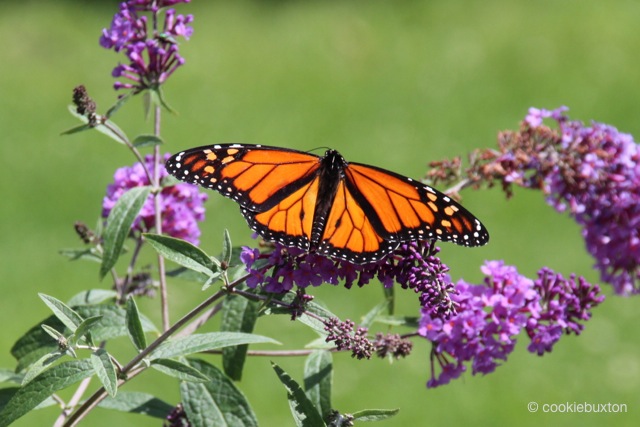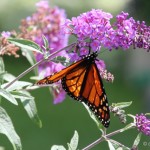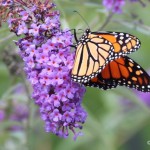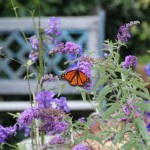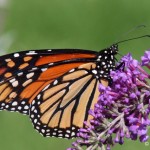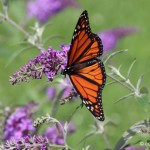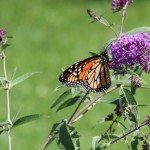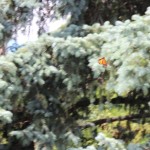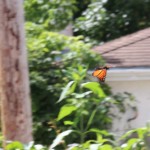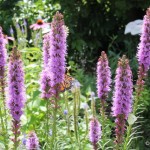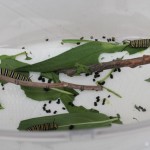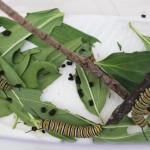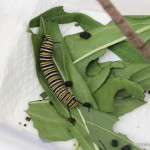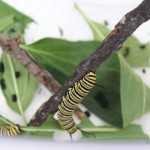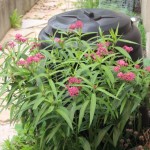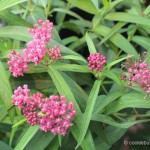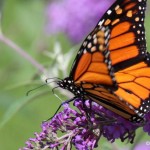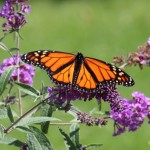Monarch Butterfly
A Monarch butterfly (Danaus plexippus) recently visited my yard, first sharing a meal with a cabbage butterfly dining on the tall purple Liatris (Liatris spicata) and then drinking the nectar of other nearby flowers. It was thrilling to have this special visitor, and to watch for over an hour as it collected the droplets of nectar from some of its favourite flowers.
I am hoping most of us are aware by now that the “common” Monarch, native in North America’s temperate zone and migrating between Mexico and its various breeding destinations, moving northward and further north into Canada, has suffered a serious decline in population due to the disappearance of its breeding host plant, milkweed.
The Monarch, in common with most other butterflies, lays its eggs on one type of plant only. For the Monarch, the host plant is milkweed. In addition to wild milkweed, which is difficult to transplant, there are a number of cultivated varieties that serve well as host plants. Watch for the sale of milkweed in your local nursery if you wish to create Monarch butterfly habitat in your area. Restoration of milkweed throughout its range, and locally in our fields and parks, ditches, back lanes, and yards will help maintain this gorgeous species in our eco-system.
The large Monarch, with its up to four-inch wingspan, is the only North American butterfly that makes such an extensive cross-continental trek each year – though it is one generation that flies north from Mexico to its summer breeding grounds throughout the United States and Canada and a different generation, never having made this flight, that returns to Mexico when temperatures drop in September. For those that reproduce in the middle and northern regions of Canada, the trek is truly remarkable. Tagged Monarchs have been recorded as flying 8,000 kilometres and more during this annual migration to or from Mexico.
Arriving at its summer breeding ground in my region in Manitoba, the female, having been fertilized while emerging from her chrysalis or later during a mating dance, seeks out its milkweed host plant and lays a tiny, usually single, egg on the underside of a milkweed leaf, flower, or seedpod. When the caterpillar develops from the egg, it eats the milkweed and in doing so, ingests toxic glycosides that are distasteful and poisonous to most of its predators. The Monarch caterpillar’s bright white and black stripes broadcast the fact that it is not a tasty meal and is, in fact, dangerous for most predators to eat
In due course, reaching the end of its maturing period, the caterpillar searches out a location to pupate. Once this location is selected, it spins silk to anchor itself to a milkweed stem, or sometimes another location elsewhere, and hangs itself upside down. Then it sheds its caterpillar skin for the final time, revealing its new chrysalis underneath. As the Monarch caterpillar’s chrysalis dries out, it becomes a pale green colour with small seam of shiny gold dots, distinctive for this species.
In July, during one of my morning walks, I stopped to admire a women’s garden and she generously showed me her Monarch caterpillars that she was monitoring from her garden milkweed. She showed me her collection of six caterpillars that she had set into special containers to observe the chrysalis stage. This isn’t something you should do unless you are well educated in the Monarch life cycle as she was. The photographs of the caterpillar and pink milkweed in the Photo Gallery are images from this woman’s yard and containers. Her plan was to observe the two-week chrysalis process and be at hand when the butterflies emerge and first open their wings.
All along the life cycle of the butterfly, little miracles of life are happening, but this final stage is the magical one that captures our hearts and imaginations. The caterpillar more or less liquefies inside its little capsule, reorganizes, and transforms into a fully mature butterfly.
The period of one hour when the butterfly emerges from its chrysalis is a critical timeline in the life cycle of the Monarch. The wings of the butterfly have to dry in this one-hour period. If the wings are touched, or bumped, or disturbed, they will not open and dry properly and the butterfly will be unable to survive. As well, the butterfly’s tongue is in two pieces, and these two pieces are enjoined in that hour to form the probiscis. The butterfly must wait for its wings to dry and its tongue to form before it flies and begins its butterfly life.
The life span of the adult Monarch butterfly, like so many other butterflies, is short. The buttlerfly will live for possibly two to six weeks, spending the time finding a mate and finding food. For the generation born late in August, part of that short lifetime will be spent travelling back to western Mexico where the females will hopefully find suitable habitat and again lay their eggs, carrying on the cycle of life for this gorgeous and special creature.
Resources:
There are easily found online resources with information on Monarchs.
The Life Cycle of Butterflies by Judy Burris and Wayne Richards, by Storey Publishing, is a terrific resource. In the United States, this book won the 2007 Teacher’s Choice Award for Children’s Books. It contains life cycle photographs and accompanying text.
Locally, there is a new resource published by Turnstone Press in 2014 called Manitoba Butterflies: A Field Guide, written by Simone Hébert Allard.
There is an encouraging note about a slight upturn in population reported by Canada’s CBC. Numbers had dropped from 1 billion Monarchs making the annual migration two decades ago to the lowest-ever level of 35 million in 2014. That number is considered perilously low for the species and efforts are needed to restore habitat. Visit: http://www.cbc.ca/news/technology/monarch-butterfly-numbers-may-come-back-from-record-low-1.2886201
Photos and Text: copyright Nadine Kampen / Cookie Buxton
Photograph locations: Butterflies – home garden; caterpillars – Winnipeg
Photographic Gallery
Click on any image to enlarge, and again on the photo to advance through the series.
